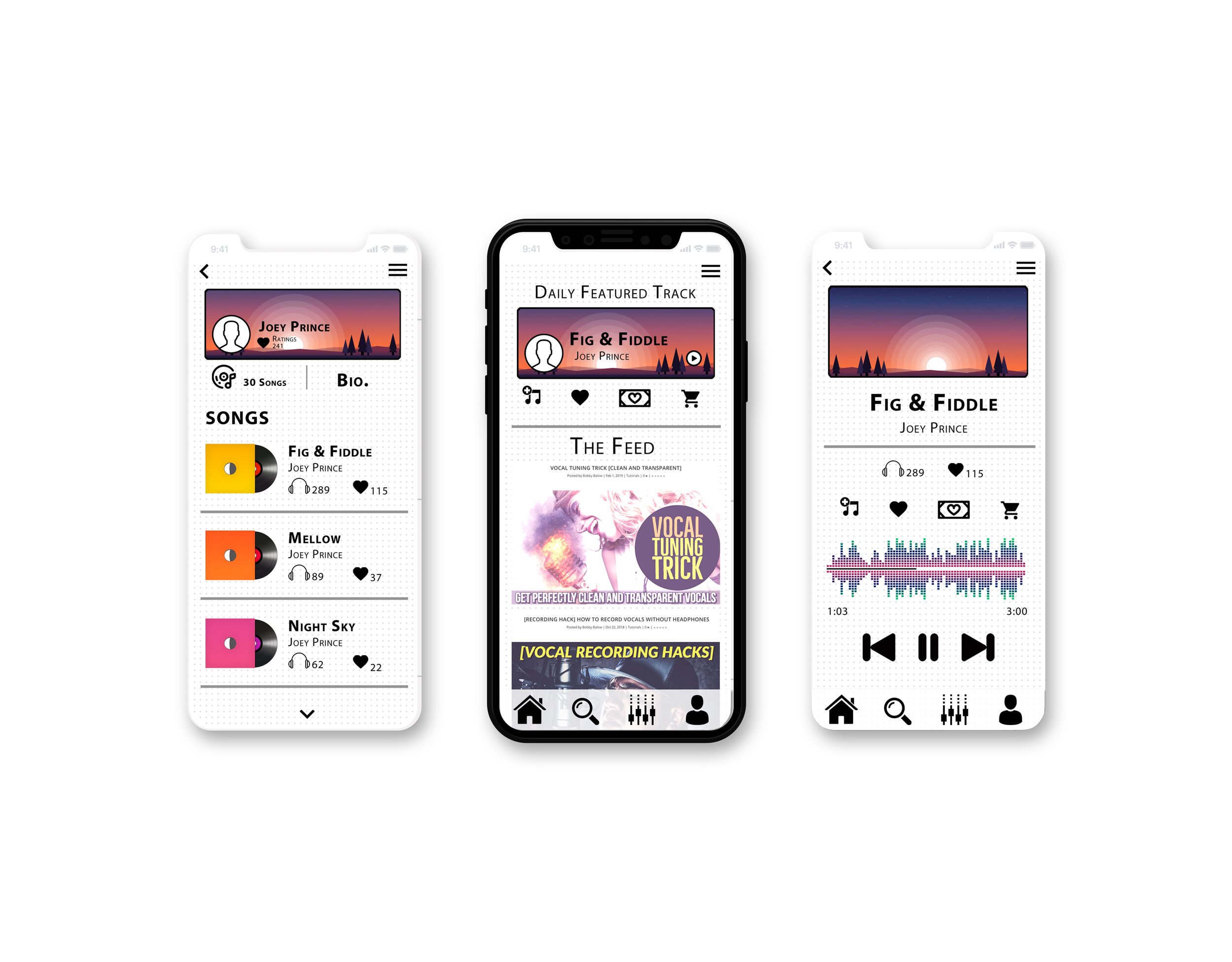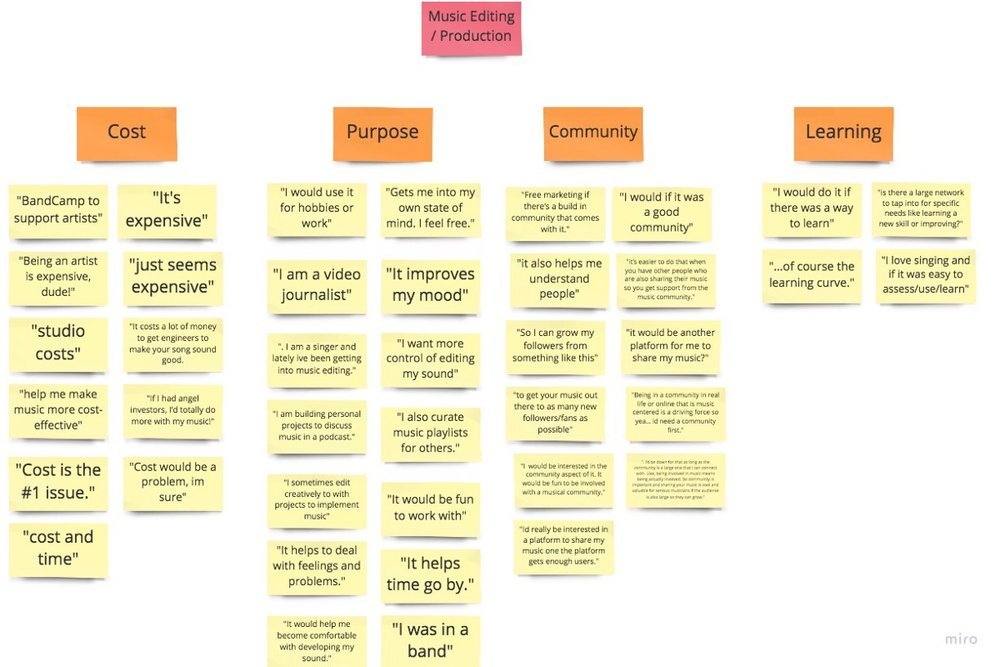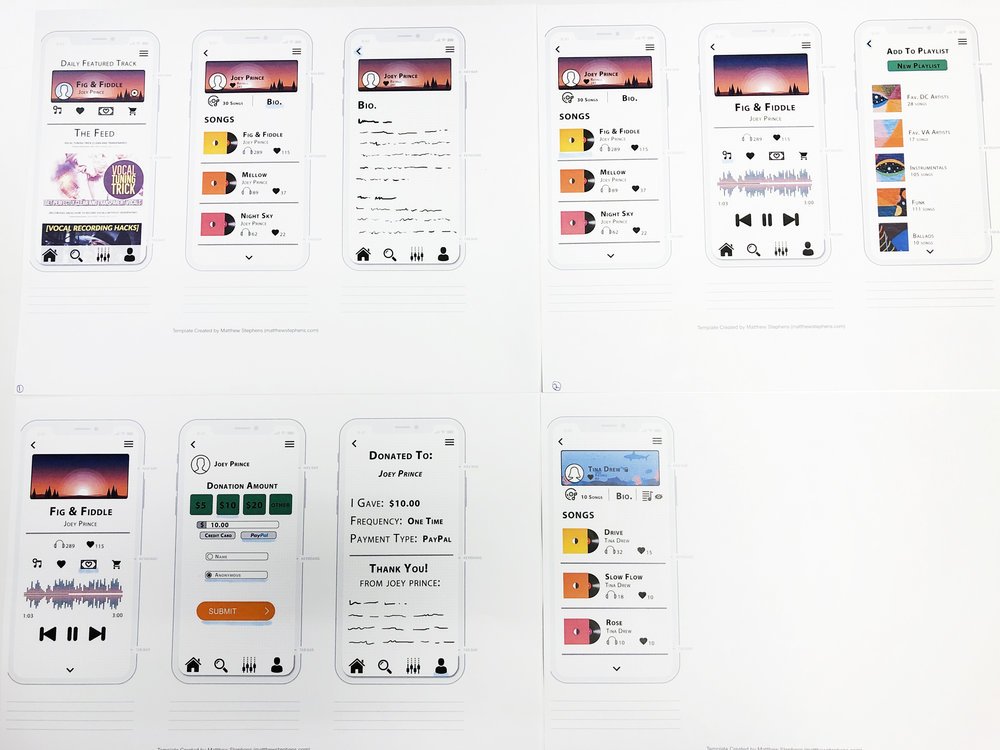Raytown Productions
Created a clickable prototype of a mobile app and developed social engagement plus music editing. Implemented a rapid prototyping method that utilized research through user interviews, user flows and wireflows.
Low fidelity mobile app designed in Balsamiq. Rapid prototyping.
This Case Study has been published on Medium: UX Planet.
The Client
Raytown Productions is a “professional and affordable online mixing, mastering, and production studio based in Alexandria, VA.” Bobby Balow owns and operates this studio and has build a significant clientele on the east coast for over 15 years. In addition, Raytown Productions offers online education, tutorials and tips for music, production and home studio owners using his website blog.
Design Objective
A Washington DC based music production company: Raytown Productions is interested in creating a robust online “tool that speaks to the needs of users. Whether it’s a collaboration, community engagement, brand building, gamification or a marketplace, the app features should be true to the needs of potential users.”
Scope & Role
Length of Project: Two Weeks, Solo Project
My Role: Lead User Research & Product Design
Contributions: User Interviews, User testing, Prototyping
Statistics
11 User Interviews (phone and in person)
3 Iterated Paper Prototypes based on User Testing
5 User Testing (two rounds)
Tools
Paper & Pencil
Balsamiq
Photoshop
Excel
UX Methodologies & Deliverables
Sketching
User Flow
Paper Prototype
User Testing
Balsamiq Clickable Prototype
User Interviews
User Research
Affinity Mapping
Mind Mapping
Secondary Research
Social Giving With Philanthropic Appeal
Empowering musicians through social engagement and community support.
“I got 16 to 32 bars to rock it, but only 15 percent of profits ever see my pocket.” — Hip-hop song: “Mathematics”
Rapper: Yasiin Bey AKA Mos Def
Understanding…
The challenge presented to me was a rather broad one. As difficult as it may have seemed to narrow down a solid concept to tackle, the project itself allowed me to explore my creativity, find restraint, and develop skills through some growing pains as an emerging UX/UI designer. Through research and analysis, I’ve been able to identify a problem and find a solution to an issue that impacts musicians from all walks of life. The pain points I discovered through my research was common to a vast majority of musicians and novices alike. Interestingly enough, the solution was found in the empathetic nature of a local Washington DC folk musician who’s a journey to develop as a musician encouraged his nature of “giving” to his peers.
Mind Mapping
I created a mind map diagram to help visually organize the information at had prior to developing my user research questions. Once I developed a hierarchy, it was easier for me to see the relationships and structure these elements by categories.
Key Problem Discovered
When considering making music, producing music, learning to become a musician, learning to become a better musician or even considering dabbling in music, everything comes at a cost. “It’s expensive!”
“…but do you realize exactly how much money you need to spend? You need to make enough money to cover equipment, one or more computers, lessons, recording, mixing, mastering, rehearsal space, industry education, cell phone, internet access, licensing fees (e.g. mechanical license), joining organizations (union, Indie Connect, NSAI etc.), attending conferences, CD duplication, website, graphic design, newsletter service (e.g. Mail Chimp), wardrobe, a manager, booking agent, entertainment attorney, photographs, a publicist, press release distribution, video production, graphic design etc. This list can go on and on depending on the level you’re at, or are trying to reach!” — Vinny Ribas
Research
I conducted a two-week long case study, interviewing 11 young professionals to further explore potential consumer needs for the client. The topic explored was music production and engagement.
A few open-ended user research questions I asked: How can a digital platform for music editing be of use to you?
81% listed that a digital platform for music editing would be of use to them in various ways.
18% had no use for music editing.
How much time do you devote to music intake daily?
100% listed consuming music daily at various rates.
What are some concerns about keeping you from professionally editing music?
73% listed that cost is the number one concern.
A major pain point I discovered through surveying people is that the majority of individuals want to do more with music but cost prohibits people from exploring that desire further.
“If I had angel investors, I’d totally do more with my music!” — M
“It is also expensive. Studio costs etc. Just seems expensive.” — B
“Cost would be a problem.” — J
“Cost is the number one issue.” — V
Secondary Research
Through secondary research, I found that financing music production is a major issue with industry professionals and not just the everyday person. In 2011, NPR (National Public Radio) put together broadcast and article in their well-known program “All Things Considered,” titled “How Much Does It Cost To Make A Hit Song?” The artist explored in the article is Rihanna and the song being financed is “Man Down.”
“Her new album has 11 songs on it. So figure that the writing camp cost about $18,000 per song.The songwriter and the producer each got a fee for their services. Rock City got $15,000 for Man Down, and the producer got around $20,000, according to Daniels.That’s about $53,000.00 spent on the song so far — before Rihanna even steps into the studio with her vocal producer.”
Affinity Mapping
Interviewing 11 people provided me with quite a bit of data. I prioritized key insights and that ultimately helped me identify trends in my research. After synthesizing identifiable trends, I was able to further understand some major pain points concerning my users. “Cost is the number one issue” that a large percentage of potential users expressed concerns about. Although cost was an issue, it was clear to see that need to belong to a community was just as large a variable in decision making.
Realization / Finding the “A-HA” Moment
Empathy Sketching
Now that I see the two clear problems, the solution was to address both issues in a seamless way. I then took the opportunity to use my storyboard as a method to further understand how my potential users think and feel. I sketched out a visual empathy flow that begins with the pain points and ends with a solution…
Solution
Helping Raytown Productions develop a platform for musicians and enthusiasts that will engage in community building and support is the goal I set out to accomplish. It was important for me to realize that the larger issue at hand within the music industry was something that needs serious addressing. In order for me to remain focused with the goal at hand, I had to redirect my thinking to aid in Raytown Productions mission moving forward. (Keep my thoughts local.) My next step was to create the features within an app to accommodate such a task.
Wireframe Flows
Key Features
The app created has the ability to allow Raytown Productions to provide a platform at the top of the home screen that will allow an emerging musician to be featured daily. In that section, there are options to:
Add track to a personal playlist.
Like the song and generate more social engagement and community support.
Donate to the artist and fund his/her mission/musical endeavors
Buy the track
Visit the artist’s profile and learn more
Within each user profile, these elements exist:
Upload personal music/tracks
Create playlists of songs from other artists or self
Provides a space for a personal biography or mission statement as a musician and identify where financial aid will be delegated.
Privacy settings
Easy listening to tracks/songs
Add to playlist
Like track/song
Donate to artist
Buy individual tracks/songs
All these elements allow for community engagement and building while allowing potential users to support their community of musicians and also receive support (through engagement and monetary support). Privacy settings are available for each user profile. The donation feature allows the users to retain anonymity through anonymous giving if desired. The amount being donated is also at the discretion of the giver. Payment options include PayPal for further online security. Finally, each donation is validated with an online tracking system, a receipt and a formatted “thank you” from the recipient of the donations.
User Flow
During the testing process, I received feedback on my prototype that allowed me to further address issues with functionality. Errors were corrected (including a back button, spacing, avoiding “featuritis” and designing for “fat thumbs”). I addressed the feedback concerns and implemented changes in my next iteration.
Mid-Fidelity, Iterated Paper Prototype
Clickable Balsamiq Prototype
Takeaways
Conceptually, this was a rather large undertaking. Although appealing to the empathetic nature of individuals is a noble idea, user feedback suggested that not everyone is interested in funding others when the cost may be an issue for the potential giver. Although only two potential consumers expressed this criticism, it’s an issue that should be taken into consideration. I learned that convincing people to buy into the idea of social giving may eliminate more casual consumers of the app.
Next Steps
In furthering the production of this app, more market research has to be conducted. A key component moving forward will be to look at competitors like BandCamp in determining what incentives potential users engaging in Raytown’s services will receive. How viable is this concept in attracting and retaining new users?
After careful evaluation and feasibility testing, a high fidelity product can be developed. As community awareness grows and social giving becomes a norm, further iterations can be implemented to accommodate the growing community. This app aims to develop a meaningful connection between the arts and the human condition. Supporting your creative community is giving back to the fabric of what makes society truly beautiful. This is a goal for many of the individuals I interviewed. This concept goes beyond connecting within the virtual realm and allows us to share in a human connection.










